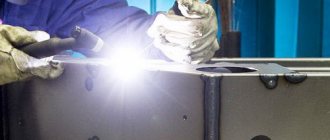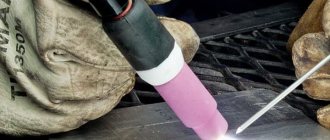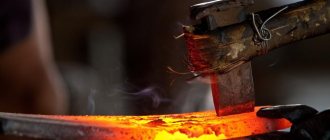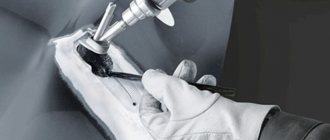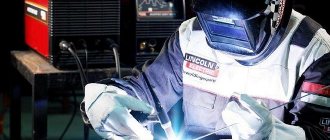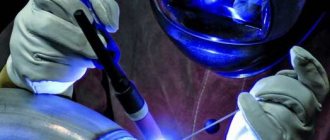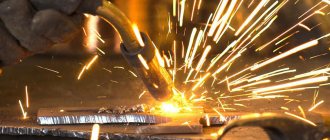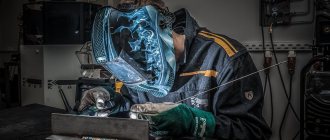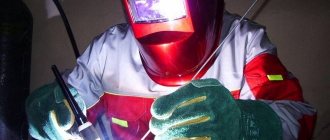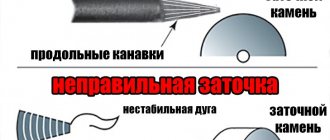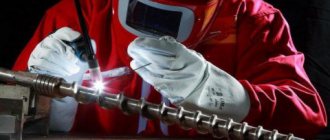Welding is one of the most popular methods of permanently joining metal parts. There are three main types of technology:
- with significant force (pressure) without heating - so-called “cold welding”;
- with medium force and heat;
- without pressure, but with heating to the melting temperature of the metal.
In this case, usually, when talking about welding, they mean the last option - that is, heating the parts to be joined to the melting point using electricity, gas flame, laser beam, and so on. We will look at one of the most popular types of “hot” welding – argon. It would be more correct to call it argon-arc, or even more precisely, arc in an argon environment, since the heating process occurs under the action of an electric arc in an inert gas (argon) environment.
Operating principle
The need to supply shielding gas to the welding zone is due to the fact that the heated metal - both the electrodes and the parts being welded - oxidize very quickly in an oxygen environment. In this case, the protective film of oxides leads to a slowdown in heating and difficulty in welding as such. That is why welding machines with a gas nozzle supplying inert or active gas. To create the required gas environment, inert gases are used (the already mentioned argon and helium), as well as active ones - carbon dioxide, nitrogen, hydrogen, and sometimes gas mixtures are also used.
According to international designations, work in a protective inert gas environment is marked metal inert gas (MIG). In the USA, the designation GMAW is adopted, and marking 13 (numeric designation) is also used. You can clarify in more detail the rules for designating the type of welding in GOST R ISO 4063-2010 (Russian analogue of the ISO 4063:2009 standard).
Argon welding can be performed in the following modes and conditions:
- manual, with non-consumable electrode. Marking RAD (manual argon arc);
- automatic with non-consumable electrode (AMA);
- automatic with consumable electrode (AADP). The last letter in the marking indicates the use of a consumable electrode.
Sometimes manual welding with a consumable electrode (MAW) is also used, but more often the welder supplies the filler material during the work.
Tungsten wire is most often used as a non-consumable electrode, which can withstand significant temperatures and conducts current well.
The welding process using a consumable electrode looks like this.
The welding machine is connected to a container with gas using a special hose - a gas supply channel and a power cable pass through it in a single hose. When creating an electric arc, gas is immediately supplied so that it completely envelops the welding site. As the electrode melts, it is automatically fed into the welding zone. Drops of molten metal falling on the seam between the parts being welded form a weld joint.
If a non-consumable electrode is used, then the supply of molten metal to form a weld is carried out by a filler (filler wire), which is manually (rarely automatically) supplied to the welding zone.
How does the work happen?
To weld, you need special equipment, such as a torch.
The torch, designed for welding in an argon environment, is equipped with a tungsten non-consumable electrode - the main part on which the device operates.
The electrode is located outside the device body (approximately 2-5 mm).
Video:
On the inside, the burner is equipped with a special holder, thanks to which you can use electrodes of different sizes - the holder is able to fix them all.
However, the size of the electrode is selected in accordance with the metal that will be processed, and the energy consumption during operation also depends on it.
Next to the electrode inside there is a nozzle made of ceramic - it is put on so that it surrounds the electrode. With the help of a nozzle, gas will flow into the work area, so this element is also very important.
To work with your own hands, you will definitely need an additive, or, in other words, filler wire - it is made from a material the same as metal blanks.
The diameter of the filler wire must also correspond to the metal you are processing - its exact size can be found in a specialized table.
Welding in an argon environment in manual mode is the most accessible method, easily repeatable with your own hands for beginners.
In this case, the filler wire and torch must be held by the welder.
Before you start welding, you need to degrease the surface of pipes, discs made of steel, brass and other metals with which you are working, and also clean them from oxidation.
Cleaning can be done mechanically or chemically, depending on your preferences and capabilities.
The first stage of welding is the same as in the arc process: a “mass” must be applied to the workpiece.
If you are processing small parts made of steel or other material, then the feed can be carried out simply into the area of the workbench or bath where the work takes place.
With this welding method, there is no wire in the electrical circuit and will be fed separately a little later.
The torch should be fixed in one hand of the master, and the wire in the other. The burner is always equipped with a button that regulates the supply of gas and current.
Gas should be supplied earlier - 20s before the start. When choosing amperage and pressure, you need to focus on the type of material being processed, or your past experience of working with your own hands.
IMPORTANT TO KNOW: Tips for welding aluminum with electrodes
The torch, equipped with an electrode, should be located very close to the material you are working with - at a distance of about 2 mm.
At this distance between the metal and the electrode, an electric arc will appear that can melt the edge of the parts; you just need to direct it in the right direction.
The entire welding process can be followed in a video for beginners - watch it before you start working with your own hands.
This proximity of the location between the electrode and the metal is explained by the fact that in this case a short arc is obtained, and it determines how deeply a part made of steel, stainless steel or other material will be fused.
If the arc is large, then the seam will turn out to be very wide and ugly, this will be especially noticeable on the coating of pipes, disks or decorative objects made of stainless steel, brass, etc.
In addition to the aesthetic factor, a large seam makes the welding of lower quality - the larger it is, the less stable it is, and the greater the stress in it.
The filler wire is fed into the work area through slow, gradual movements: the torch should move along the seam, avoiding crossing the seam across.
The quality of the seam depends on how well the equipment works, as well as on the skills of the craftsman: the smoother and clearer the movements, the better you can make a seam on the surface of pipes, disks made of stainless steel, brass or other metals.
If the wire is fed through the equipment too sharply, the metal will begin to splash, which can be dangerous.
Reproducing the argon welding technology correctly with your own hands is not so easy if you have never done it - smooth and accurate movements are achieved only through practice.
However, it is not worth starting to learn argon welding, because... this is a very complex process.
When working, it is best for the wire to be located in front of the burner.
The torch and wire should be positioned at an angle to the work area, this way it will be easier to make a straight and narrow seam.
To ignite the arc during welding, you will need specialized equipment - an oscillator.
It sends pulses with a high volt content to the electrodes, which are responsible for the ionization processes of the arc gap.
Video:
The usual mains voltage is 220V; with this power, the oscillator is capable of converting and supplying voltage up to 6000V while maintaining a frequency of up to 500 kHz. Thanks to this power, ignition of the electrode occurs quickly and easily.
Equipment that complies with GOST is the only way to properly ignite an electrode, since it is prohibited to ignite it from the surface being welded due to the high ionization potential, which with this ignition method will lead to contamination of the metal of pipes, steel disks, brass and other materials.
Pros and cons of argon arc welding
The use of inert gases, despite their higher cost, gives better welding results, since even at high heat levels they do not release oxygen (as hydrogen does). Accordingly, there is no need to introduce a deoxidizing agent (manganese or silicon) into the electrode material. Also, when argon or helium welding, there is less spattering of hot metal.
The use of inert (noble) gases is due to the fact that they are 40% heavier than atmospheric air and, when supplied to the welding zone, completely displace it. Thanks to this, there is no oxygen in the zone, and the oxidation process stops. In addition, argon, when highly heated, forms and maintains a conductive plasma. This, in turn, makes it easier to ignite the arc, and also improves heating of the edges of the parts being welded.
In addition to the already mentioned high quality of this type of permanent connections, it is worth noting the following advantages of arc welding in a protective atmosphere of inert gas (argon):
- the ability to work with various metals and obtain a strong seam regardless of the spatial position of the parts - the device can be turned as desired during work, even “upside down”. This is especially useful for welding cylindrical objects (such as pipes);
- a wide range of thicknesses of welded elements - from fractions of a millimeter to several centimeters;
- a constant supply of gas to the welding zone cools the metal to the extent that the formation of cracks and other damage due to uneven temperature distribution is noticeably reduced, but the welding ability is maintained;
- control of the quality of the seam and the state of the weld pool is extremely simple and is carried out visually;
- the impact zone is very narrow and has little effect on the thermal state of the parts as a whole;
- there is no need to clean the seams when multilayer welding; even with single-layer welding, welding seams do not need cleaning or other processing;
- work productivity is very high.
Unfortunately, there are also disadvantages:
- due to the relatively large size of the burner, it is difficult, and sometimes impossible, to work in hard-to-reach places and narrow gaps;
- adding a gas cylinder, hoses, and reducer to the required set of equipment increases both the weight of the equipment and its cost;
- protection from heat and light radiation during the welding process is required;
- You need at least minimal welder training and constant practice to improve your skills.
In general, argon welding is more often used in automatic mode at large enterprises, but is also in demand for domestic needs.
Argon welding modes
Argon welding will be carried out efficiently if the optimal process mode is chosen correctly.
- The choice of polarity and direction of the current will depend on the properties of the metals being welded. Thus, with steel structures in argon welding, direct current of direct polarity is used. For welding aluminum or beryllium, direct current of reverse polarity is used.
- The strength of the current being welded is selected based on three components: the diameter of the electrode used, the type of metal of the parts being welded and their thickness, and polarity. The relationship of all parameters is determined by table values. Some masters make their choice based on their own experience. Here is one of the tables that determines the operating mode of titanium argon arc welding.
| Metal thickness, mm | Diameter of tungsten electrode, mm | Current strength, A |
| 0,3-0,7 | 1,6 | 40 |
| 0,8-1,2 | 1,6 | 60-80 |
| 1,5-2,0 | 2 | 80-120 |
| 2,5-3,5 | 3 | 150-200 |
- As mentioned above, the shorter the welding arc, the better the quality of the seam. The same dependence of arc voltage and its length.
- The consumption of inert gas depends on the strength and uniformity of its flow leaving the burner. Experts recommend creating a laminar flow. That is, gas is supplied without pulsations.
Choosing the right mode is not an easy task. Therefore, even during the learning process, you need to study theory and master practical skills.
What you can work with
Considering the high temperature achieved by using arc welding in an argon environment, the list of metals that can be welded by this method is quite large:
- almost all “ferrous” alloys, from cast iron to structural steels;
- stainless steel (stainless steel);
- alloyed and high-alloyed alloys;
- refractory metals, including titanium and alloys based on them;
- “non-ferrous” metals, including copper, aluminum, alloys based on them.
The temperature and welding conditions are adjusted depending on the material of the parts being joined.
What are the challenges of welding stainless steel?
The difficulty of welding stainless steel is explained by the properties of this metal, which alloying additives give it. Compared to low-carbon steel, stainless steel has lower thermal conductivity (two times lower), which is a negative factor for welding work. Due to the low thermal conductivity of the metal, high temperature will be concentrated at the place where the connection is made and not actively removed from it. This can cause the joint area to overheat and even burn through the metal. That is why the stainless steel welding technology provides for a reduction in the welding current: its value is selected 20% lower than when welding conventional steels.
Display of semi-automatic welding machine with digital indication of operating current and voltage
Another characteristic of stainless steel that must be taken into account when welding is an increased coefficient of linear expansion and, as a consequence, significant linear shrinkage. It is this property of stainless steel that causes parts made from it to undergo significant deformations when performing welding work, often leading to the appearance of cracks on their surface. Taking this into account, a larger gap should be left between the workpieces being connected, which will compensate for deformation processes.
Stainless steel has increased electrical resistance, which has a very negative effect on welding if it is performed with a high-alloy steel electrode. Such an electrode, which also has high electrical resistance, begins to heat up greatly. This leads to deterioration in the quality of the formed weld. If you are going to cook stainless steel with such electrodes, you should use products of a minimum length.
A weld crack is the most dangerous defect leading to structural failure
If the correct thermal conditions are not observed when welding stainless steel, this alloy may lose its anti-corrosion properties.
This is explained as follows. With significant heating (over 500 degrees), chromium and iron carbide begin to form at the boundaries of crystalline grains of the metal. This is how pockets of corrosion appear and further spread. To avoid this negative phenomenon, which is called intergranular corrosion, it is necessary to very quickly cool stainless steel parts immediately after completing welding work. However, this method is effective only if you are welding stainless steel of the chromium-nickel group.
Required equipment, supplies and protection
When planning to do argon manual welding at home (automatic machines are usually not used at home), you should stock up on everything you need in advance:
- gas cylinder. For argon, specialized cylinders are used, the difference from oxygen and propane cylinders is in the colors. They have a characteristic silver-gray color;
- reducer to reduce the pressure of liquefied gas. Can be specialized or general purpose;
- a high-pressure hose (from the cylinder to the reducer) and a similar or less durable one - from the reducer to the welding torch;
- a welding machine designed to work with non-consumable electrodes;
- electrodes of a suitable brand in the required quantity;
- tools and devices for preparing metal for welding;
- protective clothing and equipment.
It is important to understand that the compatibility of the cylinder, hose and reducer is very important. To avoid confusion, manufacturers try to produce reducers and cylinders in the same color and with similar markings.
More about the equipment
Please note that the previously provided information about the color of the argon cylinder (silver-gray) refers to PURE (specially prepared) gas.
It is also necessary to pay attention to the marking of the cylinder itself and its condition.
The condition of the threads and seals should be examined especially carefully, since the performance of the cylinder as a whole and the safety of its use depend on this.
It is advisable to use the reducer with a rotameter (one or two), that is, a gas flow sensor and regulator. Two rotameters are necessary if two welders will use the gas cylinder at the same time. The presence of a rotameter allows you to rationally use both the gas itself and tungsten electrodes - after all, with excessive gas pressure, they burn out much faster.
With regard to electrodes, it is necessary to adhere to the general rule regarding the type of welding (AC or DC).
The diameter of the product is selected depending on the thickness of the metal to be welded.
The same goes for the required welding amperage.
The last parameter, as well as the ability to use different electrode diameters, greatly influences the choice of welding machine.
We will not consider the nuances of choosing a specific device model within the framework of this article, since the topic is too broad.
Preparing parts
To weld any metal, it must first be prepared for work. This procedure includes several steps:
- editing details. Often the parts that need to be welded are deformed. The basic shape must be restored, otherwise joining for welding may be impossible or very difficult. Straightening is performed manually or using automatic equipment, “cold” or in a heated state (using a gas burner). The choice of a specific method depends on the characteristics of the part, its condition and the capabilities of the craftsman;
- cleaning surfaces. It is necessary to remove the corroded layer and any paint and varnish coatings from the part. This is usually done by hand sanding or wire sanding with a drill/grinder;
- marking and cutting. Marking at home is done only by hand; cutting is carried out with a grinder or a special metal saw (including using a jigsaw). For thin sheet metal, you can use scissors. Thermal cutting is also possible - using a gas cutter, electric arc, and so on;
- preparing edges for work. Depending on the thickness of the metal you plan to weld, straight, V-shaped and X-shaped edges are used. The mechanically or thermally cut edge of a part must be brought to any condition using a suitable hand tool. In this case, it is better to use “cold” cutting methods, since after thermal cutting, the cleanliness of the cut to form a chamfer or a flat surface may not be sufficient. Additionally, the edges can be cleaned from the oxide film using a wire brush or a grinding attachment.
Another important point is the removal of stains of oils, fats and other organic and inorganic contaminants. They are removed with appropriate solvents.
The last stage of preparation is assembling the parts in the required position. For this purpose, various stands, conductors, etc. are often used. Particular care should be taken when welding pipes and other hollow parts joined at the edges.
Types of edges for welding: 1 – straight edges, 2 – simple V-shaped, 3 – complex V-shaped, 4 – X-shaped
The assembly of parts must be carried out taking into account a significant increase in temperature in the welding zone - wood and other flammable materials cannot be used for the welding stand.
Advantages and disadvantages
Argon-arc welding has both features and disadvantages. Of course, there are more positive aspects to it, and they are as follows:
- You can weld not only copper and aluminum, but also steel.
- The seam is neat from an aesthetic point of view, subject to the technique of feeding the rod and applying the arc.
- Argon-arc welding of non-ferrous and ferrous metals can be done at home with your own hands if you have the necessary equipment and consumables.
- The connection is strong throughout the entire depth of the joint if the parts have been well prepared in advance. The chamfer was removed at an angle of 45 degrees, a gap was provided and the oxide film was removed from the surface.
- In this way, you can weld thin parts without penetration and other undesirable defects.
- When automating the welding process, it is performed not only efficiently, but also quickly.
The disadvantages include:
Complexity of the process. Without the right equipment, you will not be able to perform high-quality welding. In addition, it is necessary to have some experience in order to correctly feed the bar and control the arc. Therefore, a beginner in this matter will have to learn a lot.
Also, the price of professional equipment will be quite high, but you can assemble the components separately, which will be somewhat cheaper.
Protective equipment and clothing
The safety of the welder and the things around him is especially important when it comes to working in a home workshop or a small private enterprise. Mandatory elements of worker protection are:
- welding helmet, mask or goggles. A mask is the best option because it protects not only the eyes from the blinding light of an electric arc, but also the skin of the face (and partly the neck) from burns from splashes of molten metal and sparks. Also, to a certain extent, the mask protects the respiratory tract. Clear glasses are recommended for use when cutting metal and edge processing. The dark shield of the mask protects the skin from excessive and specific “welding tan”, which can cause skin cancer;
- gloves or mittens with gauntlets (protective elements on the wrists and above). The material of the gloves should be as dense as possible, non-melting (a prerequisite, since heating can be significant), and at the same time soft enough for ease of use. Tight fixation on the hands is undesirable; gloves should fit the hand loosely;
- a jacket or apron made of dense material that is not prone to fire. Can also use overalls or overalls;
- dense shoes that can easily withstand temperature influences. It is important that the shoes do not have open lacing, nails in the soles or other metal elements;
- When working in inconvenient places, with forced laying on the floor or kneeling, knee pads, special stands and mats are used.
According to regulations, welders must also use respirators. However, most often home craftsmen refuse it, citing the inconvenience of the work and its short duration.
Important: people with problems with the respiratory tract (frequent cases of bronchitis or tonsillitis, recent pneumonia, asthma or allergies) must use a respirator while welding!
The material of gloves (mittens, gauntlets) and clothing intended specifically for welders is marked “TR”, the same applies to shoes. It is recommended to manufacture workwear for welders from natural materials (tarpaulin, cotton, genuine leather) with additional impregnation with fire-retardant substances. For everyday use, thick denim or canvas clothing, long aprons and armlets (in the absence of leggings) made of canvas or leather, and leather gloves are suitable. But it is better to purchase specialized mittens or gloves.
Sequence of work during argon-arc welding
The technology of the process is outlined using the example of welding pipes with a manual welding machine and a lesson for beginners from the “Burn the Arc” channel.
Preparation of equipment, protection and parts to be welded . For work, experts recommend using inverter-based devices powered by 220V AC (industrial models with 380V power are not recommended for use in domestic conditions, even if there is an appropriate power socket).
For a novice craftsman, it is better to choose black or lightly alloyed iron-based alloys as welded parts. Taking sheets with a thickness of 2...3 mm, you can use green (WP) electrodes made of pure tungsten, without alloying additives.
Preliminary preparation of parts is described above.
Chamfering for better seam welding
Installing a holder that fixes two sections of pipe relative to each other
Tack seam . In some cases, it can be difficult to connect parts immediately with a permanent continuous seam, so craftsmen recommend in this case to make “tack welds,” that is, short seams in several places.
Performing point tacks
If spot setting was not performed entirely successfully, it is better to clean off the metal deposits to obtain a more monolithic and even seam
Making the main seam is igniting the arc. Please note that the blower is turned on first, and only then the arc
Making the main weld with a non-consumable electrode and using an additive
Type of finished seam
Seams close up
Detailed photos and videos of seams obtained using argon arc welding clearly show that they consist of many round “patches”. This is due to the fact that heating pulses are supplied at a certain interval. Accordingly, the metal melts at a specific point, forming an influx, then at the next one, and so on.
Argon welding technology
The basic principle of operation is that welding is performed using an electric arc method in a protective gas atmosphere.
Argon welding
Most non-ferrous metals, stainless steel and high-alloy steel differ from ferrous metals in that when heated they exhibit high chemical activity and interact with atmospheric oxygen, forming oxides and losing useful additives.
This significantly worsens both the properties of the weld itself and the metal in the heat-affected area. The weld becomes weak, and the alloys lose their properties due to alloying additives. The situation is even worse with aluminum and some other light metals - they ignite.
To avoid these unpleasant consequences, welding is carried out in an atmosphere of inert gas - argon, which prevents the interaction of heated metal with atmospheric oxygen. The density of argon is almost one and a half times greater than the density of air, so the inert gas replaces the air in the work area and protects it.
Argon welding can be performed with both fusible and non-fusible electrodes, usually tungsten.
Tig welding technology involves three main methods:
- MMA (RAD) manual, tungsten electrode
- MIG/MAG (AMA) automatic, infusible electrode
- TIG (AADP) – also automatic, fusible electrode
Advice from experienced welders
- One of the first recommendations is to carefully study all the information regarding the heating mode, the characteristics of the alloy, the capabilities of the welding machine and the nuances of the block of parts. It would not be amiss to familiarize yourself with examples of technological (operational) maps drawn up in production for specific welding operations. In this case, parameters such as gas flow, welding current mode, electrode feed speed (for automatic machines), thickness and material of the parts being welded are necessarily standardized.
- It is necessary to turn on the supply of argon to the zone 20 seconds before the ignition starts, and turn it off no earlier than 10 seconds after it is turned off.
- To prevent the electrode and filler wire from oxidizing, they must always be in the gas protection zone.
- The filler wire is fed into the melting zone at an angle to both the electrode and the weld. This will allow you to get a better and narrower welding strip.
- The burner should be moved along the seam carefully, without sudden transverse movements - this makes the seam uneven and excessively wide.
- The smaller the arc, the deeper and smoother the seam will be, but reducing the arc requires the electrode and filler wire to be as close as possible to the weld pool.
- It is impossible to complete the work by abruptly turning off the arc. It is necessary to weld the crater with a gradual decrease in current strength (regulated by the rheostat of the device).
- When working with voluminous or complexly shaped parts, it is necessary to provide in advance for the possibility of a gradual transition of the welder from one area to another and, accordingly, the required length of the hose and, in some cases, the use of a mobile platform for the welding machine and a cylinder with a reducer. In other cases, it is more convenient to use a rotary/movable table with the welding block rigidly fixed to it.
Types of welding equipment
Four types of equipment are used for argon welding.
- Manual (shown in the video) is when the welder holds both the torch and the filler wire with his own hands.
- Mechanized version - the welder holds the torch, and the wire is fed mechanically.
- Automatic argon arc welding - the welder is absent, he is replaced by an operator who monitors the process, because both the torch feed and the filler wire feed occur automatically.
- Robotic welding process. A program is set that is fully responsible for the process being carried out.
The most important advantage of argon arc welding is the ability to weld parts of those metals that cannot be joined in other ways. And in everyday life such situations often occur, for example, joining stainless steel pipes. Be sure to watch the video on this page of the site.
